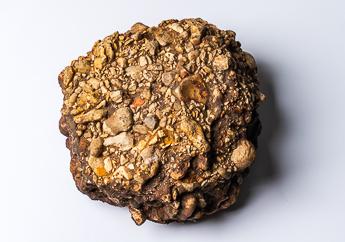
A sedimentary rock, conglomerate consists of pieces known as clasts of pre-existing rocks, pebbles, cobble or boulders that are naturally cemented together in a fine-grained matrix of sand, silt, calcium carbonate, iron oxide, silica or clay.

sedimentary matrix make up this conglomerate.
Conglomerate forms in an environment where rocks are eroded and carried in strong water currents so swiftly they aren’t broken down into sand. They form at the base of mountain ranges, as a glacial deposit, or they may make up an ancient riverbed or coastline. Because the rocks that make up conglomerate have been transported by water, the pebbles may be from a wide variety of rocks. After being deposited, they are compacted by sediments and over time, become cemented together by minerals. The conglomerate’s rounded rock particles are larger than 2 mm in diameter, so they are easily visible to the naked eye. Conglomerate provides important clues about the ancient environment because the individual stones are samples of the older rocks that were exposed as it was forming. Numerous occurrences of conglomerate exist in the state. Some include the “Chariton” conglomerate, Iron Mountain Lamotte Sandstone conglomerate, Lamine River Conglomerate Physiofacies, Pilot Knob conglomerate, Potosi slates and conglomerate, Ralls Oolitic limestone conglomerate and Rockaway conglomerate.
The Graydon Conglomerate, known to occur in scattered areas in Callaway, Cedar, Greene, St. Clair and Polk counties, is composed of large rounded cobbles and boulders of Mississippian chert redeposited during the conglomerate. A sedimentary rock, conglomerate consists of pieces known as clasts of pre-existing rocks, pebbles, cobble or boulders that are naturally cemented together in a fine-grained matrix of sand, silt, calcium carbonate, iron oxide, silica or clay.
Pennsylvanian System and cemented with silica. A similar rock type, breccia, is composed of angular fragments rather than rounded rock or mineral fragments. The Lamotte Sandstone is commonly exposed in the St. Francois Mountains of Missouri and overlies the Precambrian igneous-rock surface. The primary contact between these units is a conglomerate composed of pieces of weathered granite or rhyolite and cemented with silica.
The Dec. 14, 2005, breach of the Taum Sauk Reservoir that sent more than 1 billion gallons of water down Proffit Mountain and into Johnson’s Shut-Ins State Park near Lesterville, revealed what geologists call a conglomerate “beach.” The release of more than 1 billion gallons of water in approximately 12 minutes exposed an incredible amount of rock, including the evidence of the conglomerate beach as well as ancient volcanic activity. The deposit is made of sand-size granite and rhyolite grains that grade up to the size of boulders.
Visit the department’s Ed Clark Museum of Missouri Geology, where you will find conglomerates on display.
